Anisotropic Grain Growth in (111) Nanotwinned Cu Films by DC Electrodeposition
Abstract
:1. Introduction
2. Experimental Section
3. Results and Discussion
4. Conclusions
Author Contributions
Funding
Conflicts of Interest
References
- Cao, Z.H.; Lu, H.M.; Meng, X.K. Barrier layer and annealing temperature dependent microstructure evolution of nanocrystalline cu films. Mater. Chem. Phys. 2009, 117, 321–325. [Google Scholar] [CrossRef]
- Du, S.; Li, Y. Effect of annealing on microstructure and mechanical properties of magnetron sputtered Cu thin films. Adv. Mater. Sci. Eng. 2015, 2015, 969580. [Google Scholar] [CrossRef] [Green Version]
- Lu, L.; Shen, Y.; Chen, X.; Qian, L.; Lu, K. Ultrahigh strength and high electrical conductivity in copper. Science 2004, 304, 422–426. [Google Scholar] [CrossRef] [PubMed] [Green Version]
- Lu, L.; Chen, X.; Huang, X.; Lu, K. Revealing the maximum strength in nanotwinned copper. Science 2009, 323, 607–610. [Google Scholar] [CrossRef] [PubMed]
- Chen, K.-C.; Wu, W.-W.; Liao, C.-N.; Chen, L.-J.; Tu, K.N. Observation of atomic diffusion at twin-modified grain boundaries in copper. Science 2008, 321, 1066–1069. [Google Scholar] [CrossRef] [PubMed] [Green Version]
- Hsiao, H.-Y.; Liu, C.-M.; Lin, H.-w.; Liu, T.-C.; Lu, C.-L.; Huang, Y.-S.; Chen, C.; Tu, K.J.S. Unidirectional growth of microbumps on (111)-oriented and nanotwinned copper. Science 2012, 336, 1007–1010. [Google Scholar] [CrossRef] [Green Version]
- Humphreys, F.J.; Hatherly, M. Recrystallization and Related Annealing Phenomena; Elsevier: Amsterdam, The Netherlands, 2012. [Google Scholar]
- Thompson, C.V. Grain growth in thin films. Annu. Rev. Mater. Sci. 1990, 20, 245–268. [Google Scholar] [CrossRef]
- Thompson, C.V.; Carel, R.J.; Solids, P.O. Stress and grain growth in thin films. J. Mech. Phys. Solids 1996, 44, 657–673. [Google Scholar] [CrossRef]
- Thompson, C.V. Grain growth and evolution of other cellular structures. In Solid State Physics; Elsevier: Amsterdam, The Netherlands, 2001; Volume 55, pp. 269–314. [Google Scholar]
- Hau-Riege, S.P.; Thompson, C.V.J.A.P.L. In situ transmission electron microscope studies of the kinetics of abnormal grain growth in electroplated copper films. Appl. Phys. Lett. 2000, 76, 309–311. [Google Scholar] [CrossRef]
- Hang, Z.Y.; Thompson, C.V. Grain growth and complex stress evolution during volmer–weber growth of polycrystalline thin films. Acta Mater. 2014, 67, 189–198. [Google Scholar]
- Yang, S.; Zhang, J.; Chi, M.; Wen, Y.; Chen, X.; Wang, C.; Liu, X. Low-cost Cu-based shape memory single crystals obtained by abnormal grain growth showing excellent superelasticity. Materialia 2019, 5, 100200. [Google Scholar] [CrossRef]
- Zhao, B. Abnormal grain growth with {1 0 0} planar interface in the electrodeposited nickel. Mater. Res. Innov. 2015, 19, S251–S254. [Google Scholar] [CrossRef]
- Kerger, P.; Rathmann, D.; Marx, M.; Motz, C. How to produce a desired bimodal microstructure for optimized mechanical properties: Investigation of the mechanisms of abnormal grain growth in pulsed electro-deposited nickel. Int. J. Mater. Res. 2015, 106, 1131–1143. [Google Scholar] [CrossRef]
- Chen, X.-M.; Lin, Y.; Wu, F. EBSD study of grain growth behavior and annealing twin evolution after full recrystallization in a nickel-based superalloy. J. Alloy. Compd. 2017, 724, 198–207. [Google Scholar] [CrossRef]
- Asgharzadeh, H.; McQueen, H. Grain growth and stabilisation of nanostructured aluminium at high temperatures. Mater. Sci. Technol. 2015, 31, 1016–1034. [Google Scholar] [CrossRef]
- Park, H.-K.; Kang, H.-G.; Park, C.-S.; Huh, M.-Y.; Hwang, N.-M. Ex situ observation of microstructure evolution during abnormal grain growth in aluminum alloy. Metall. Mater. Trans. A 2012, 43, 5218–5223. [Google Scholar] [CrossRef]
- Park, C.-S.; Na, T.-W.; Park, H.-K.; Kim, D.-K.; Han, C.-H.; Hwang, N.-M. Misorientation characteristics of penetrating morphologies at the growth front of abnormally growing grains in aluminum alloy. Philos. Mag. Lett. 2012, 92, 344–351. [Google Scholar] [CrossRef]
- Oh, C.; Nagao, S.; Kunimune, T.; Suganuma, K. Pressureless wafer bonding by turning hillocks into abnormal grain growths in ag films. Appl. Phys. Lett. 2014, 104, 161603. [Google Scholar] [CrossRef]
- Kusama, T.; Omori, T.; Saito, T.; Kise, S.; Tanaka, T.; Araki, Y.; Kainuma, R. Ultra-large single crystals by abnormal grain growth. Nat. Commun. 2017, 8, 354. [Google Scholar] [CrossRef]
- Sonnweber-Ribic, P.; Gruber, P.A.; Dehm, G.; Strunk, H.P.; Arzt, E. Kinetics and driving forces of abnormal grain growth in thin cu films. Acta Mater. 2012, 60, 2397–2406. [Google Scholar] [CrossRef]
- Williams, B.A.; Smeaton, M.A.; Trejo, N.D.; Francis, L.F.; Aydil, E.S. Effect of nanocrystal size and carbon on grain growth during annealing of copper zinc tin sulfide nanocrystal coatings. Chem. Mater. 2017, 29, 1676–1683. [Google Scholar] [CrossRef]
- Xu, S.; Kusama, T.; Xu, X.; Huang, H.; Omori, T.; Xie, J.; Kainuma, R. Large [001] single crystals via abnormal grain growth from columnar polycrystal. Materialia 2019, 6, 100336. [Google Scholar] [CrossRef]
- Fang, F.; Zhang, Y.; Lu, X.; Wang, Y.; Lan, M.; Yuan, G.; Misra, R.; Wang, G. Abnormal growth of {100} grains and strong Cube texture in strip cast Fe-Si electrical steel. Scr. Mater. 2018, 147, 33–36. [Google Scholar] [CrossRef]
- Underwood, O.; Madison, J.; Thompson, G. Emergence and Progression of Abnormal Grain Growth in Minimally Strained Nickel-200. Metals 2017, 7, 334. [Google Scholar] [CrossRef] [Green Version]
- Rudnizki, J.; Zeislmair, B.; Prahl, U.; Bleck, W. Prediction of abnormal grain growth during high temperature treatment. Comput. Mater. Sci. 2010, 49, 209–216. [Google Scholar] [CrossRef]
- Elsey, M.; Esedog, S.; Smereka, P. Simulations of anisotropic grain growth: Efficient algorithms and misorientation distributions. Acta Mater. 2013, 61, 2033–2043. [Google Scholar] [CrossRef] [Green Version]
- Lu, C.-L.; Lin, H.-W.; Liu, C.-M.; Huang, Y.-S.; Lu, T.-L.; Liu, T.-C.; Hsiao, H.-Y.; Chen, C.; Kuo, J.-C.; Tu, K.-N. Extremely anisotropic single-crystal growth in nanotwinned copper. NPG Asia Mater. 2014, 6, e135. [Google Scholar] [CrossRef] [Green Version]
- Van, Q.D.; Kondo, K. Low thermal expansion coefficient electrodeposited copper and its contraction mechanism by annealing. ECS J. Solid State Sci. Technol. 2017, 6, P566–P569. [Google Scholar] [CrossRef]
- Agrawal, P.M.; Rice, B.M.; Thompson, D.L. Predicting trends in rate parameters for self-diffusion on fcc metal surfaces. Surf. Sci. 2002, 515, 21–35. [Google Scholar] [CrossRef]
- Li, J.; Yu, X.; Shi, T.; Cheng, C.; Fan, J.; Cheng, S.; Liao, G.; Tang, Z. Low-temperature and low-pressure cu–cu bonding by highly sinterable cu nanoparticle paste. Nanoscale Res. Lett. 2017, 12, 255. [Google Scholar] [CrossRef] [Green Version]
- Warcholinski, B.; Kuznetsova, T.; Gilewicz, A.; Zubar, T.; Lapitskaya, V.; Chizhik, S.; Komarov, A.; Komarova, V.; Kuprin, A.; Ovcharenko, V. Structural and mechanical properties of Zr-Si-N coatings deposited by arc evaporation at different substrate bias voltages. J. Mater. Eng. Perform. 2018, 27, 3940–3950. [Google Scholar] [CrossRef] [Green Version]
- Zubar, T.I.; Fedosyuk, V.M.; Trukhanov, A.V.; Kovaleva, N.N.; Astapovich, K.A.; Vinnik, D.A.; Trukhanova, E.L.; Kozlovskiy, A.L.; Zdorovets, M.V.; Solobai, A.A. Control of Growth Mechanism of Electrodeposited Nanocrystalline NiFe Films. J. Electrochem. Soc. 2019, 166, D173–D180. [Google Scholar] [CrossRef]
- Zubar, T.; Trukhanov, A.; Vinnik, D. Influence of surface energy on ni-fe thin films formation process. In Materials Science Forum; Trans Tech Publishers: Zurich, Switzerland, 2019; pp. 228–234. [Google Scholar]
- Xu, D.; Kwan, W.L.; Chen, K.; Zhang, X.; Ozoliņš, V.; Tu, K. Nanotwin formation in copper thin films by stress/strain relaxation in pulse electrodeposition. Appl. Phys. Lett. 2007, 91, 254105. [Google Scholar] [CrossRef]
- Xu, D.; Sriram, V.; Ozolins, V.; Yang, J.-M.; Tu, K.; Stafford, G.R.; Beauchamp, C. In situ measurements of stress evolution for nanotwin formation during pulse electrodeposition of copper. J. Appl. Phys. 2009, 105, 023521. [Google Scholar] [CrossRef] [Green Version]
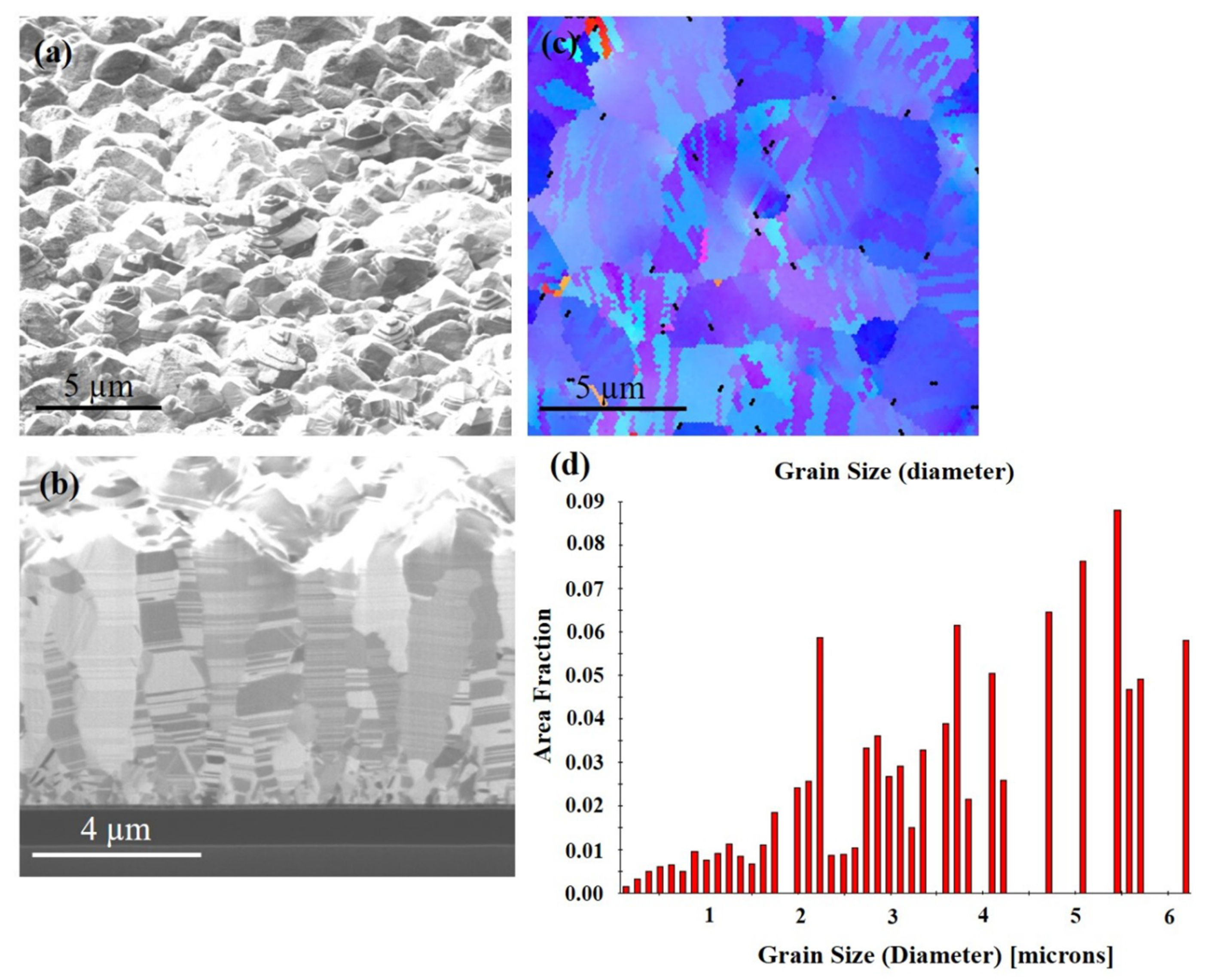
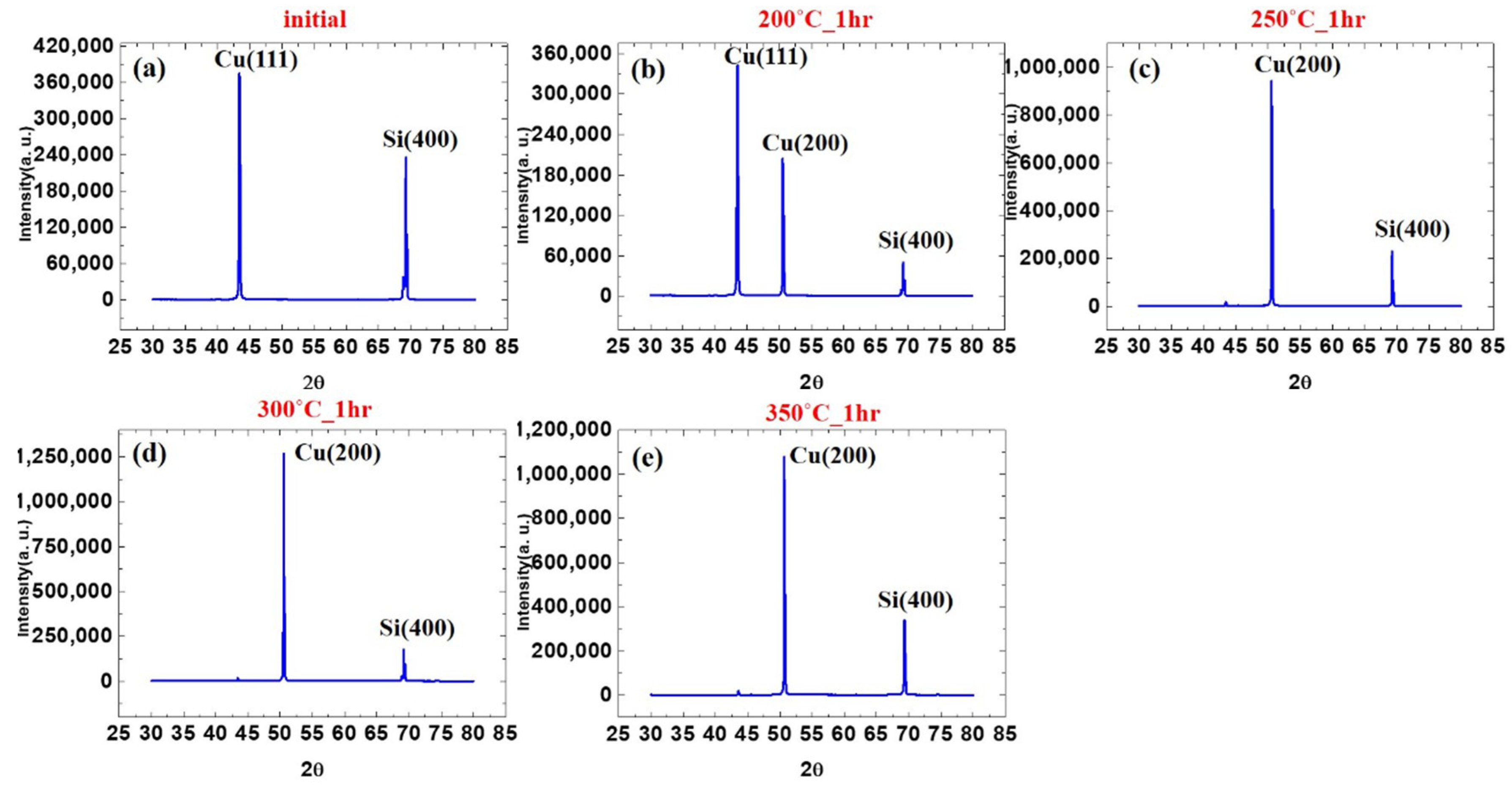


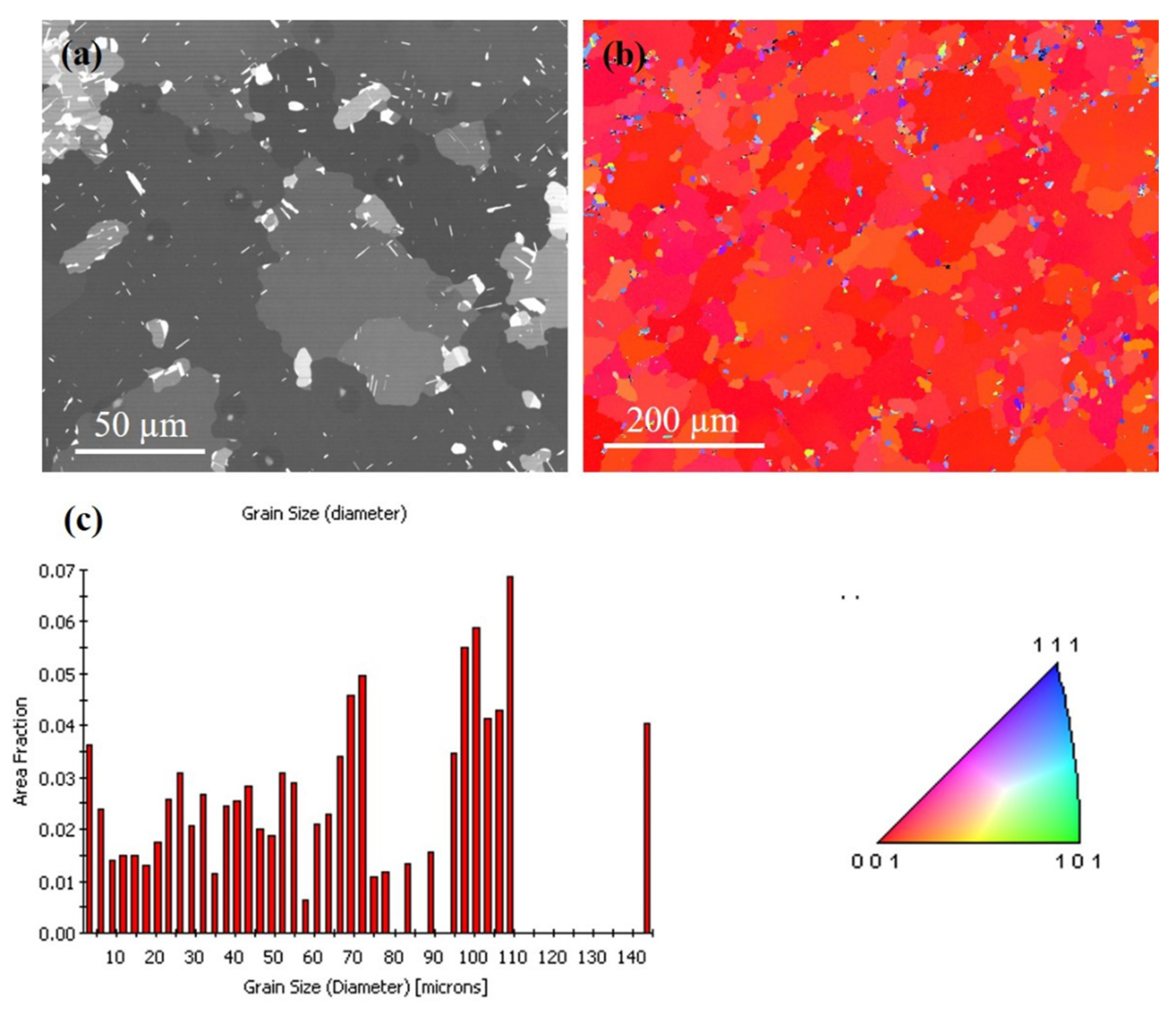
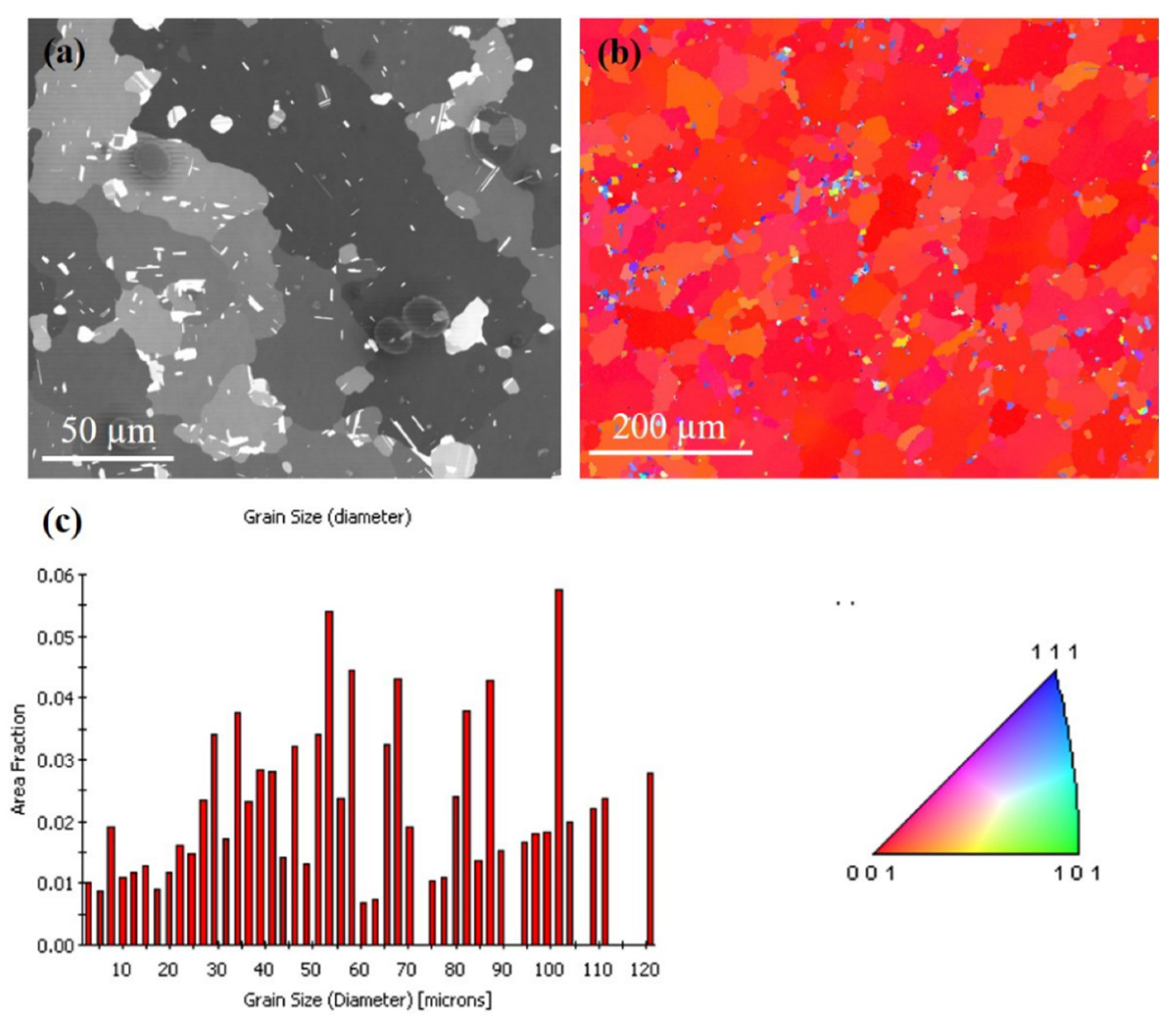


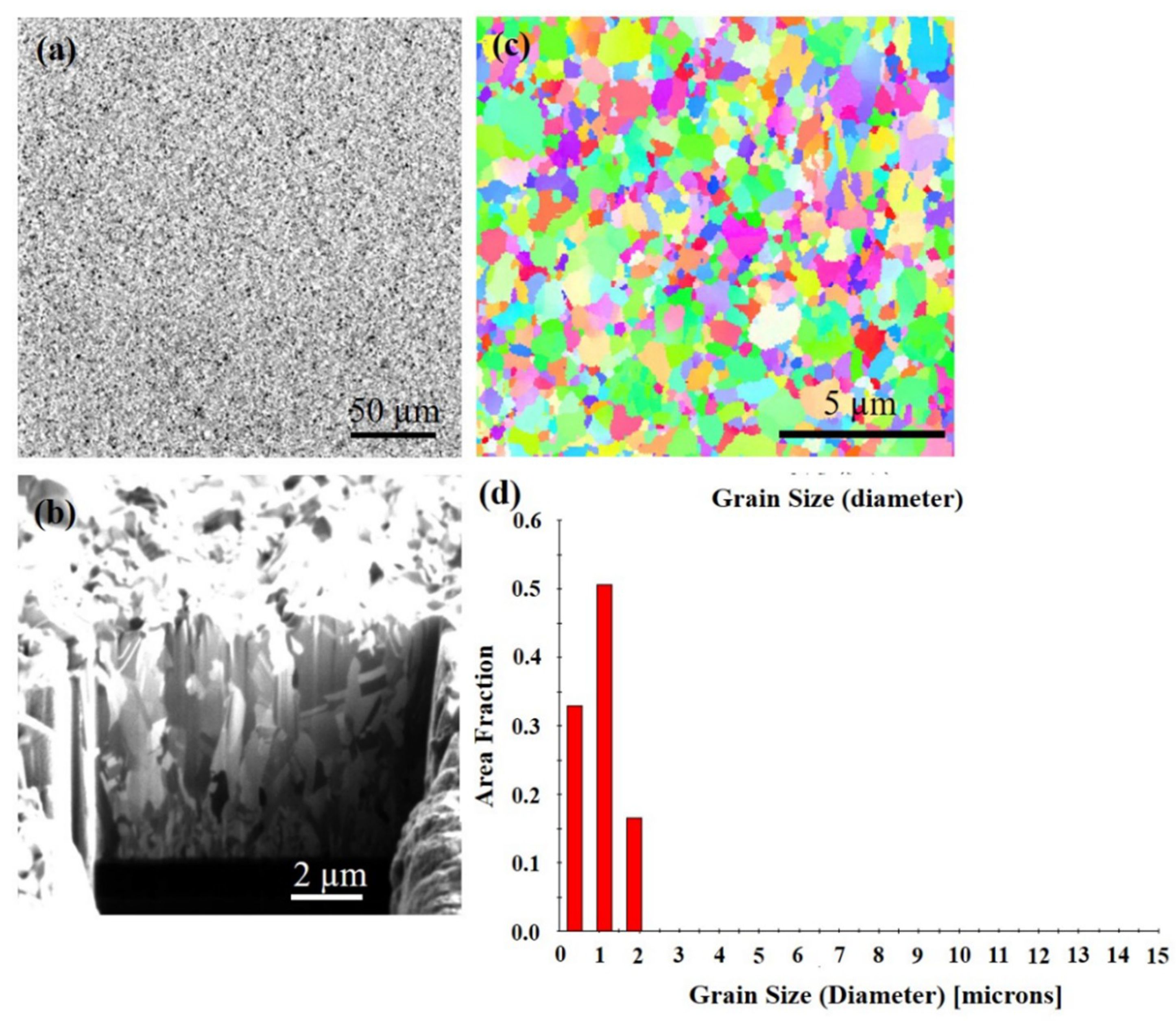
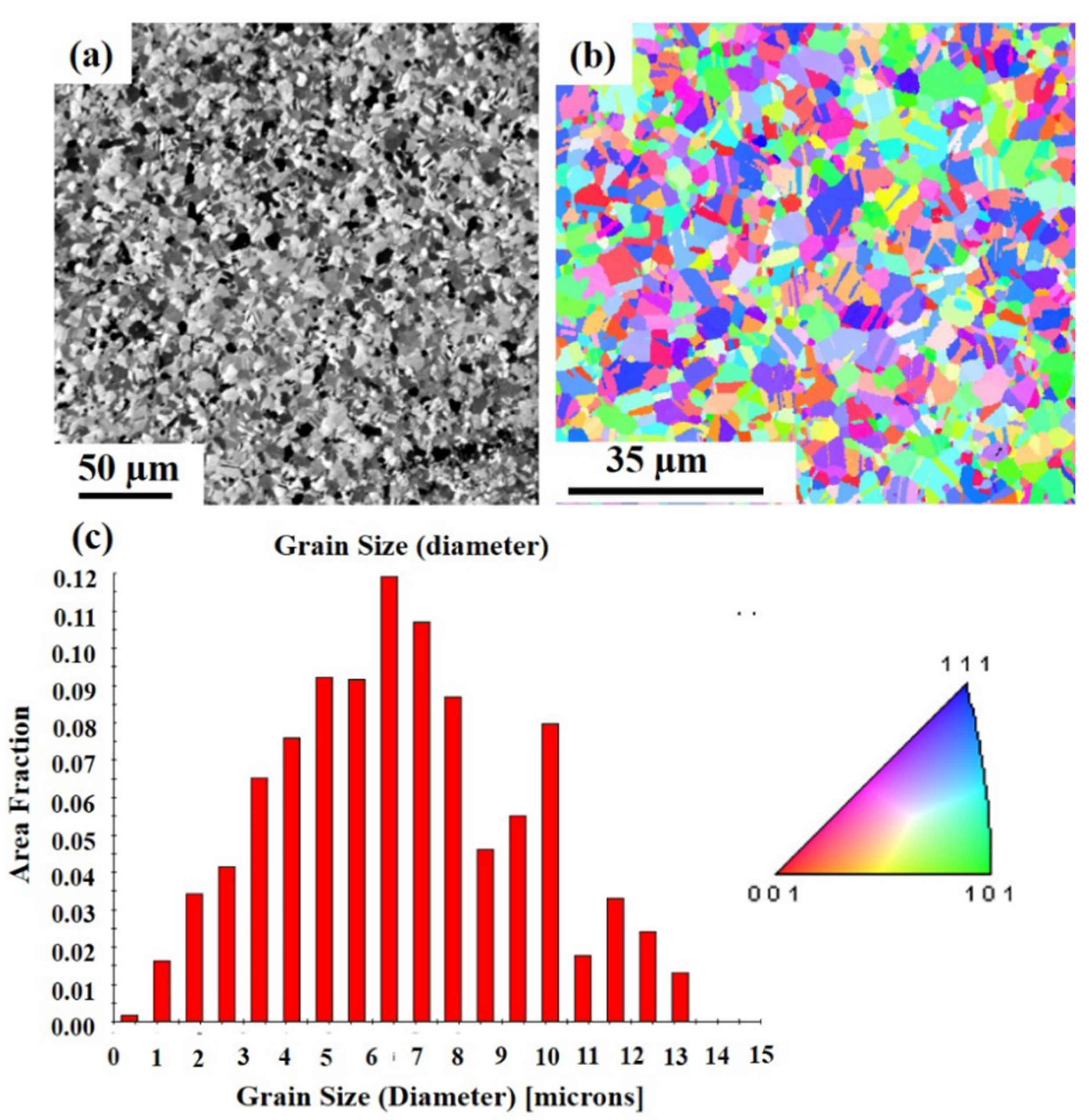
© 2019 by the authors. Licensee MDPI, Basel, Switzerland. This article is an open access article distributed under the terms and conditions of the Creative Commons Attribution (CC BY) license (http://creativecommons.org/licenses/by/4.0/).
Share and Cite
Lu, T.-L.; Shen, Y.-A.; Wu, J.A.; Chen, C. Anisotropic Grain Growth in (111) Nanotwinned Cu Films by DC Electrodeposition. Materials 2020, 13, 134. https://doi.org/10.3390/ma13010134
Lu T-L, Shen Y-A, Wu JA, Chen C. Anisotropic Grain Growth in (111) Nanotwinned Cu Films by DC Electrodeposition. Materials. 2020; 13(1):134. https://doi.org/10.3390/ma13010134
Chicago/Turabian StyleLu, Tien-Lin, Yu-An Shen, John A. Wu, and Chih Chen. 2020. "Anisotropic Grain Growth in (111) Nanotwinned Cu Films by DC Electrodeposition" Materials 13, no. 1: 134. https://doi.org/10.3390/ma13010134
APA StyleLu, T.-L., Shen, Y.-A., Wu, J. A., & Chen, C. (2020). Anisotropic Grain Growth in (111) Nanotwinned Cu Films by DC Electrodeposition. Materials, 13(1), 134. https://doi.org/10.3390/ma13010134






